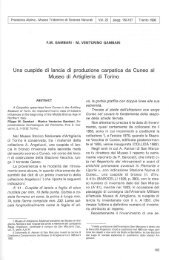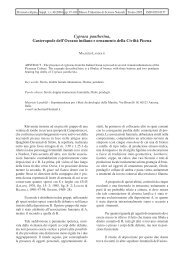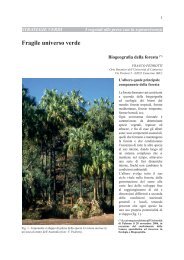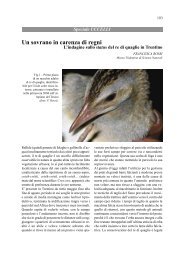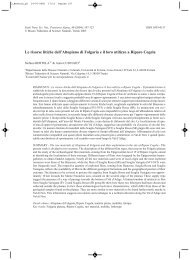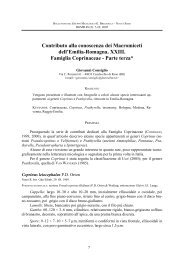Science at Museo delle Scienze - Museo Tridentino di Scienze ...
Science at Museo delle Scienze - Museo Tridentino di Scienze ...
Science at Museo delle Scienze - Museo Tridentino di Scienze ...
Create successful ePaper yourself
Turn your PDF publications into a flip-book with our unique Google optimized e-Paper software.
The main results and projects 2010-2011<br />
ecological stability vs variability: insights from long-term stu<strong>di</strong>es<br />
on springs<br />
Section of Limnology and Phycology<br />
There has been a growing interest in<br />
long-term stu<strong>di</strong>es because they offer opportunities<br />
for tracking and understan<strong>di</strong>ng<br />
temporal changes in bio<strong>di</strong>versity.<br />
Without the temporal context provided<br />
by long-term d<strong>at</strong>a, the inherent dynamics<br />
of ecological systems cannot be<br />
quantified, putting <strong>at</strong> risk our decisions<br />
about bio<strong>di</strong>versity management. since<br />
<strong>at</strong> least 16 years the limnology and Phycology<br />
section of the <strong>Museo</strong> <strong>delle</strong> scienze<br />
is studying a set of springs examining<br />
temporal changes of the environmental<br />
factors and of the <strong>di</strong><strong>at</strong>om communities.<br />
The working group showed th<strong>at</strong> stability<br />
is a multifaceted <strong>di</strong>mension, which<br />
assumes <strong>di</strong>fferent meanings accor<strong>di</strong>ng<br />
to the main underlying process. For<br />
instance, an important source of variability<br />
was due to random fluctu<strong>at</strong>ion of<br />
the least abundant species, which occur<br />
from year to year mainly by chance.<br />
But while this effect was present in the<br />
<strong>di</strong><strong>at</strong>om communities of all springs, nonstochastic<br />
mechanisms were <strong>di</strong>fferently<br />
represented. in two springs, changes<br />
were <strong>di</strong>rectional but not explained by<br />
the environment, suggesting th<strong>at</strong> internal,<br />
within springs, drivers may be more<br />
important than extrinsic forces. overall,<br />
these results provide a benchmark of <strong>di</strong><strong>at</strong>om<br />
variability over time and in n<strong>at</strong>ural<br />
con<strong>di</strong>tions, delimiting the “limits of acceptable<br />
changes”.<br />
The long-term ecological research programme<br />
on spring habit<strong>at</strong>s benefited gre<strong>at</strong>ly<br />
from inclusion in the ACQUA-TEST_ PNAB<br />
Project (2008-ongoing) funded by the Adamello-Brenta<br />
N<strong>at</strong>ure Park, in the CRENO-<br />
DAT Project (2004-2007) funded by the Autonomous<br />
Province of Trento, and in a previous<br />
(2003-2004) Project on long-term ecological<br />
research in selected springs funded<br />
by the Adamello-Brenta N<strong>at</strong>ure Park.<br />
spitale d. & canton<strong>at</strong>i M., 2011 - understan<strong>di</strong>ng<br />
the n<strong>at</strong>ural variability of <strong>di</strong><strong>at</strong>om assemblages<br />
in springs of the Adamello-Brenta<br />
n<strong>at</strong>ure Park (south-eastern Alps) on a temporal<br />
scale. Fundamental and Applied Limnology<br />
179 (2): 137-149.<br />
31<br />
1R<br />
2R 2r<br />
3R<br />
4R<br />
5R<br />
6R



